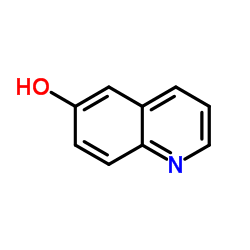6-Hydroxyquinoline

6-Hydroxyquinoline structure
|
Common Name | 6-Hydroxyquinoline | ||
|---|---|---|---|---|
| CAS Number | 580-16-5 | Molecular Weight | 145.158 | |
| Density | 1.3±0.1 g/cm3 | Boiling Point | 313.0±15.0 °C at 760 mmHg | |
| Molecular Formula | C9H7NO | Melting Point | 188-190 °C(lit.) | |
| MSDS | Chinese USA | Flash Point | 143.1±20.4 °C | |
| Symbol |

GHS07 |
Signal Word | Warning | |
|
Synthesis and antimosquito properties of 2,6-substituted benzo[d]thiazole and 2,4-substituted benzo[d]thiazole analogues against Anopheles arabiensis.
Eur. J. Med. Chem. 65 , 295-303, (2013) A novel and efficient one pot synthesis was developed for 2,6-substituted-benzo[d]thiazole analogues 4a-k and 2,4-substituted-benzo[d]thiazole analogues 4l-pvia three component condensation reaction of substituted arylaldehyde, 2-amino-6-halo/4-methyl-benzo[d... |
|
|
TDDFT study of the polarity controlled ion-pair separation in an excited-state proton transfer reaction.
Spectrochim. Acta. A. Mol. Biomol. Spectrosc. 128 , 280-4, (2014) 6-Hydroxyquinoline (6HQ) is an ideal photoacid system for exploring excited-state proton transfer (ESPT) reactions. We have previously (Mahata et al. (2002)) shown that the ESPT reaction between 6HQ and trimethylamine (TMA) leads to an "unusual" emission in t... |
|
|
Excited-state prototropic equilibrium dynamics of 6-hydroxyquinoline encapsulated in microporous catalytic faujasite zeolites.
Chemistry 16(42) , 12609-15, (2010) The excited-state proton transfer and geminate recombination of 6-hydroxyquinoline (6HQ) encaged in catalytic Na(+)-exchanged faujasite zeolites X (NaX) and Y (NaY) have been explored by measuring steady-state and picosecond time-resolved spectra. The pathway... |
|
|
Excited state proton transfer in the Cinchona alkaloid cupreidine.
Phys. Chem. Chem. Phys. 12(39) , 12562-9, (2010) Photophysical properties of the organocatalyst cupreidine (CPD) and its chromophoric building block 6-hydroxyquinoline (6HQ) in protic and nonprotic polar solvents (methanol and acetonitrile) were investigated by means of UV-vis absorption, and steady state a... |
|
|
Excited-state proton transfer via hydrogen-bonded acetic acid (AcOH) wire for 6-hydroxyquinoline.
J. Phys. Chem. A 115(1) , 19-24, (2011) Spectroscopic studies on excited-state proton transfer (ESPT) of hydroxyquinoline (6HQ) have been performed in a previous paper. And a hydrogen-bonded network formed between 6HQ and acetic acid (AcOH) in nonpolar solvents has been characterized. In this work,... |
|
|
Proton translocation and electronic relaxation along a hydrogen-bonded molecular wire in a 6-hydroxyquinoline/acetic acid complex.
J. Phys. Chem. B 112(28) , 8383-6, (2008) A hydrogen-bonded network formed between 6-hydroxyquinoline (6-HQ) and acetic acid (AcOH) has been characterized using a time-resolved fluorescence technique. In the bridged hydrogen-bonded complex of cis-6-HQ and AcOH, an excited-state reaction proceeds via ... |
|
|
Microbial metabolism of quinoline and related compounds. IX. Degradation of 6-hydroxyquinoline and quinoline by Pseudomonas diminuta 31/1 Fa1 and Bacillus circulans 31/2 A1.
Biol. Chem. Hoppe-Seyler 372(6) , 381-3, (1991) Two strains, using 6-hydroxyquinoline as sole source of energy, carbon and nitrogen, have been isolated. These bacteria, designated 31/1 Fa1 and 31/2 A1, are also able to degrade quinoline. According to their physiological properties strain 31/1 Fa1 has been ... |
|
|
Fluorescence characteristics of protonated form of 6-hydroxyquinoline in Nafion film.
Spectrochim. Acta. A. Mol. Biomol. Spectrosc. 59(3) , 559-67, (2003) Fluorescence characteristics of 6-hydroxyquinoline (6-HQ) have been studied at room temperature in Nafion(R) film by steady state and nano-second time-resolved fluorescence spectroscopy. The fluorescence spectrum exhibits single emission band corresponding to... |
|
|
Selective phenolic acylation of 10-hydroxycamptothecin using poly (ethylene glycol) carboxylic acid.
Bioorg. Med. Chem. Lett. 13(3) , 577-80, (2003) Selective acylation of the phenolic hydroxyl group of 10-hydroxycamptothecin has been accomplished using phenyl dichlorophosphate. Additional modification of the 10-OH as an ether permits a 20-acyl derivative to be synthesized. This result along with data fro... |
|
|
Quinolin-6-ol at 100 K.
Acta Crystallogr. C 65(Pt 2) , o66-9, (2009) The title compound, C(9)H(7)NO, has two symmetry-independent molecules in the asymmetric unit, which have different conformations of the hydroxy group with respect to the quinoline ring. One of the molecules adopts a cis conformation, while the other shows a ... |